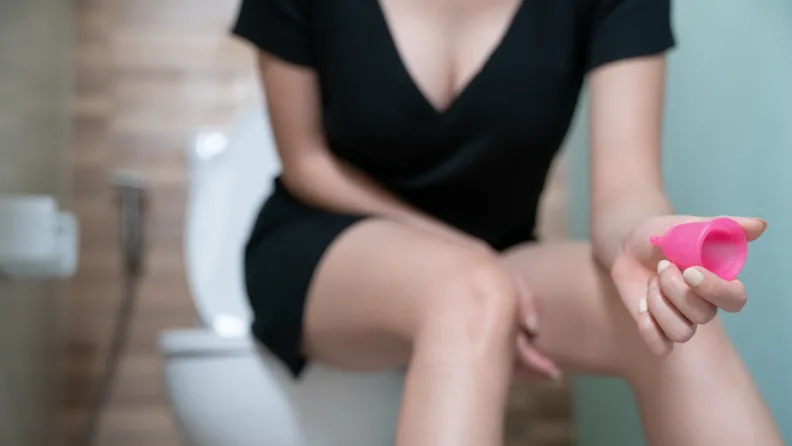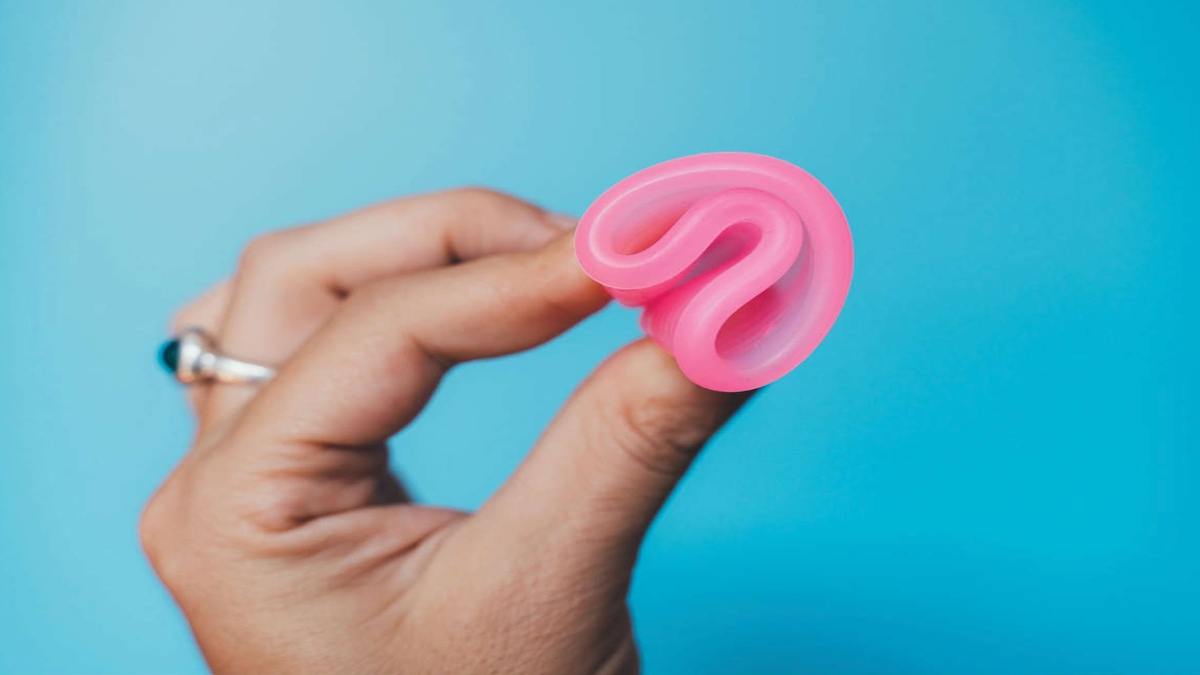If you’ve recently made the switch to zero-waste period care and are wearing a menstrual cup for the first time, you might be wondering if it’s safe to pee with it in. Rest assured, it is absolutely safe! You don’t have to remove your cup every time you need to use the toilet. Once you have inserted your menstrual cup correctly, you shouldn’t even feel its presence. It sits in the vaginal canal, away from the urethra, which is where your pee comes from. So go ahead and relieve yourself without any worries.
Contents
Can You Pee with a Menstrual Cup In?

When it comes to using a menstrual cup, one common concern is whether it’s possible to pee while wearing one. The good news is that peeing with a menstrual cup is completely normal and hassle-free. You don’t need to remove the cup every time you need to use the toilet.
The cup sits in the vaginal canal, away from the urethra where your pee comes from, so there is no risk of accidents or discomfort. In fact, if you have inserted your menstrual cup correctly, you shouldn’t be able to feel its presence at all. It’s designed to create air suction, which keeps the cup intact inside the vagina.
It’s important to note that there may be slight movement or shifting of the cup during urination or bowel movements. This is completely normal and does not indicate a problem. Your pelvic muscles are in action during these activities, which can cause the cup to shift slightly.
If you feel that there is a leak after you pee, it’s important to remove and re-insert the cup to avoid leakage. This can happen occasionally, but it’s not a cause for concern. Simply empty the cup, rinse it, and re-insert it to ensure a proper seal.
Overall, using a menstrual cup can make your period care routine more convenient and comfortable. You don’t have to worry about constantly changing pads or tampons, and you can wear the cup for up to 12 hours at a time without any issues. So rest assured, you can pee with a menstrual cup in without any problems or discomfort.
Using the Menstrual Cup for Peeing
Anatomy and Urinary System
To understand how using a menstrual cup affects urination, it’s important to have a basic understanding of your anatomy and urinary system. The urethra, a small tube, is responsible for carrying urine from the bladder out of the body. This tube is separate from the vaginal canal, where the menstrual cup sits comfortably in place.
How Menstrual Cups Affect Urination
When it comes to peeing with a menstrual cup in, rest assured that it’s entirely safe and hassle-free. The cup is specifically designed to sit in the vaginal canal, away from the urethra. This means there is no risk of accidents or discomfort while urinating.
During urination or bowel movements, you may experience slight movement or shifting of the cup. This is completely normal and does not indicate a problem. The cup is flexible and moves with your body, allowing you to empty your bladder without any issues.
Tips for Peeing with a Menstrual Cup
If you’re concerned about leaks after urination, there are a few tips to keep in mind:
- Empty your bladder completely: Make sure to fully empty your bladder before inserting the menstrual cup. This can help prevent any urine from getting trapped in the cup and causing leaks.
- Ensure a proper seal: After inserting the cup, ensure that it has created a proper seal against the vaginal walls. This will help prevent any leaks during urination. You can check the seal by running a clean finger around the cup’s rim to ensure it is fully open.
- Take your time: When using the restroom, take your time to relax and allow your body to naturally release urine. Rushing can cause unnecessary pressure on the cup and potentially lead to leaks.
- Consider adjusting the position: If you find that you consistently experience leaks after urination, you may need to adjust the position of the cup. Gently remove the cup, empty it, and re-insert it, ensuring a proper seal and a comfortable fit.
By following these simple tips, you can confidently use your menstrual cup while peeing without any worries of leaks or discomfort. Remember, practicing good hygiene and thoroughly cleaning your cup between uses is essential for maintaining a healthy menstrual care routine.
So go ahead and enjoy the convenience and comfort that using a menstrual cup brings, even during your bathroom breaks.
Common Concerns and Solutions

Leakage and Overflow
One common concern when it comes to peeing with a menstrual cup is the potential for leakage or overflow. While the cup is designed to sit in the vaginal canal, away from the urethra, it is still possible for urine to escape. Here are a few solutions to help prevent leakage and ensure a worry-free experience:
- Ensure a proper seal: Before inserting the cup, make sure it is fully unfolded and creating a seal against the walls of the vagina. This will help prevent any leaks during urination.
- Empty your bladder completely: To minimize the risk of overflow, it’s important to empty your bladder fully before inserting the cup. This will give you more capacity for urine and reduce the chances of any accidents.
- Take your time: While urinating with a menstrual cup in, it’s important to take your time and allow the urine to flow naturally. Rushing can increase the chances of leakage, so relax and let your body do its thing.
- Adjust the position of the cup: If you notice any leaks or discomfort while peeing, it may be necessary to adjust the position of the cup. Gently wiggle it or rotate it slightly to ensure a better fit and prevent any accidents.
Odor and Hygiene
Another concern that may arise when using a menstrual cup for peeing is odor and hygiene. However, with proper care and maintenance, these concerns can be easily addressed. Here are a few tips to keep your cup clean and odor-free:
- Practice good hygiene: Before and after using the restroom, make sure to wash your hands thoroughly with soap and water. This will help minimize the risk of any bacteria transfer.
- Clean the cup between uses: After each use, it’s important to clean the cup with warm water and a mild, unscented soap. Avoid using harsh chemicals or scented products, as they can cause irritation.
- Boil the cup: To ensure proper sterilization, it’s recommended to boil your cup at the end of each menstrual cycle. Simply place the cup in a pot of boiling water for a few minutes, then allow it to cool and dry before storing it.
- Store the cup properly: When not in use, store your cup in a clean, breathable bag or container. Avoid keeping it in airtight spaces, as this can promote the growth of bacteria and unpleasant odors.
Can Using a Menstrual Cup Make it Difficult to Pee?
Using a menstrual cup does not make it difficult to pee. The cup is designed to sit comfortably in the vaginal canal, away from the urethra. This means there is no risk of accidents or discomfort while urinating.
It’s important to note that slight movement or shifting of the cup during urination is normal and does not indicate a problem. However, to prevent any leaks after urination, there are a few things you can do:
- Ensure a proper seal: Before inserting the cup, make sure it forms a tight seal against the vaginal walls. This will help prevent any leaks during urination.
- Empty your bladder completely: It’s important to empty your bladder fully before inserting the menstrual cup. This will help avoid any pressure on the cup and minimize the risk of leaks.
- Take your time: While urinating, take your time and relax. Rushing can cause the cup to move or shift, potentially leading to leaks.
- Adjust the cup if necessary: If you experience any discomfort or leaks while urinating, try adjusting the position of the cup. Gently push it higher or lower to find a more comfortable fit.
By following these simple steps, you can ensure a hassle-free experience when using a menstrual cup. Remember, the cup is designed to be safe and convenient to use, allowing you to go about your daily activities without any disruptions.
Do You Need to Remove a Menstrual Cup Every Time You Pee?

No, you do not need to remove a menstrual cup every time you pee. One of the great benefits of using a menstrual cup is that it can be worn for up to 12 hours, even during urination. The cup is designed to sit comfortably in the vaginal canal, away from the urethra, so there is no risk of accidents or discomfort.
During urination, it is normal for the cup to shift slightly or move a bit. This movement does not indicate a problem and is unlikely to cause any leakage. However, to prevent leaks after urination, it is essential to ensure a proper seal. Here are a few tips to help you maintain a leak-free experience:
- Empty the Bladder: Before inserting the menstrual cup, make sure to empty your bladder completely. This will help minimize the chances of any urine getting trapped in the cup and causing leaks.
- Take Your Time: While urinating, take your time and relax. Rushing can lead to accidental spills or difficulty in ensuring a proper seal.
- Adjust the Position: If you notice any leaking after urination, try adjusting the position of the cup. Gently rotate the cup or push it up slightly to create a better seal. Remember, practice makes perfect, and it may take a few tries to find the most comfortable and leak-proof position for your cup.
It is important to note that the menstrual cup should be cleaned and rinsed between uses, including after each time you empty it. Maintaining good hygiene is essential to prevent any potential infections or odors. So, make sure to wash your hands thoroughly before and after handling the cup.
Conclusion
Using a menstrual cup for peeing is a safe and hassle-free option. The cup is specifically designed to sit in the vaginal canal, away from the urethra, ensuring that there is no risk of accidents or discomfort. It is completely normal for the cup to slightly move or shift during urination, so there’s no need to worry. To prevent leaks after urination, it is crucial to ensure a proper seal, empty the bladder completely before inserting the cup, take your time while urinating, and adjust the position of the cup if needed. Additionally, practicing good hygiene and cleaning the cup between uses is essential. Overall, using a menstrual cup can greatly enhance your period care routine, offering convenience and comfort.
Frequently Asked Questions
Do menstrual cups leak less than tampons?
Leakage is similar or lower for menstrual cups compared to disposable pads or tampons, according to The Lancet. This is great news for those wanting to save money, protect the environment, and enjoy more freedom during their period.
What do gynecologists say about menstrual cups?
Gynecologists recommend menstrual cups across age groups. They are environmentally friendly, budget-friendly, and help maintain vaginal pH and eco flora, preventing vaginal infections.
Is inserting a menstrual cup messy?
Inserting and removing a menstrual cup can be messy, especially for beginners. If you’re uncomfortable with menstrual blood, using a cup may not be the best option for you.
Is it easy to pee while using a menstrual cup?
Yes, it is easy to pee while wearing a menstrual cup. The cup sits in the vaginal canal, away from the urethra, so there is no interference. You can urinate with ease while wearing a cup.
What if my menstrual cup fell in the toilet while pooping?
If your menstrual cup falls into the toilet, don’t panic. Retrieve it using toilet paper, wipe it clean, and boil it for 8-10 minutes. Consider having a period emergency kit with you to handle such situations.
I am a medical student with experience and interest in Women’s health and well-being.